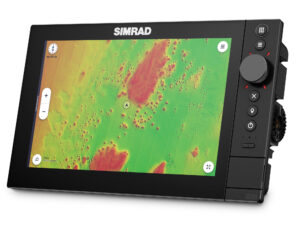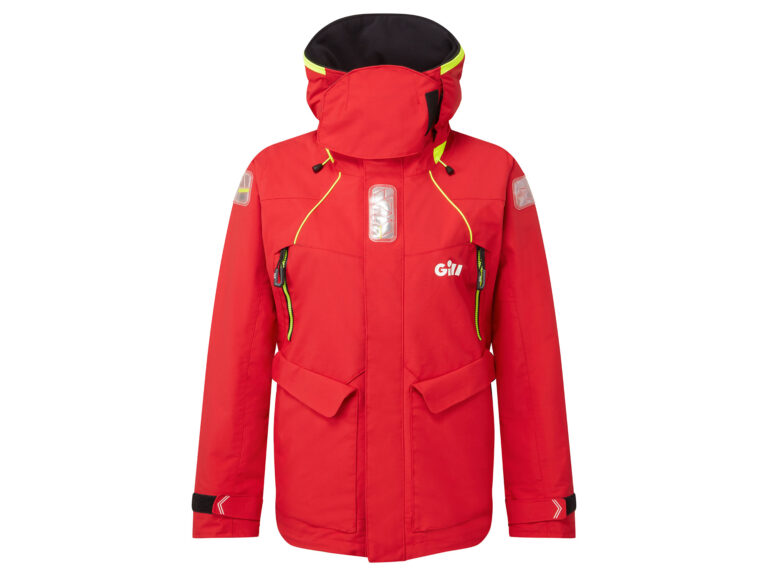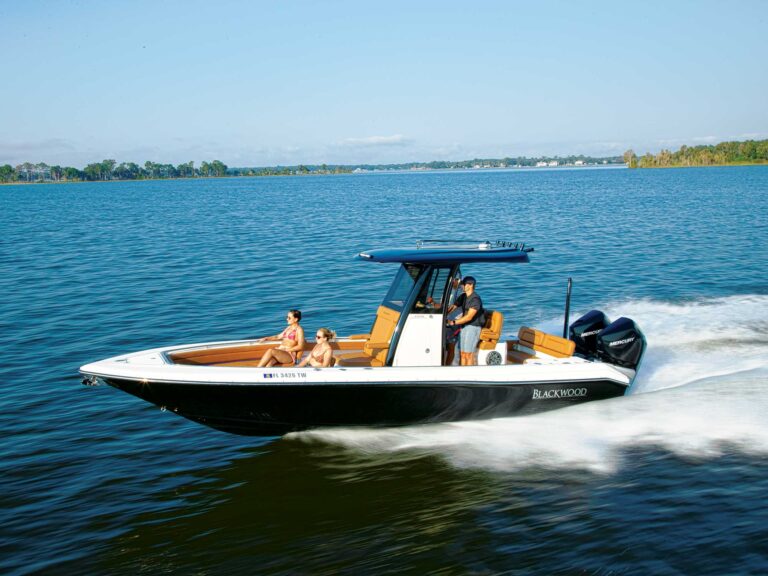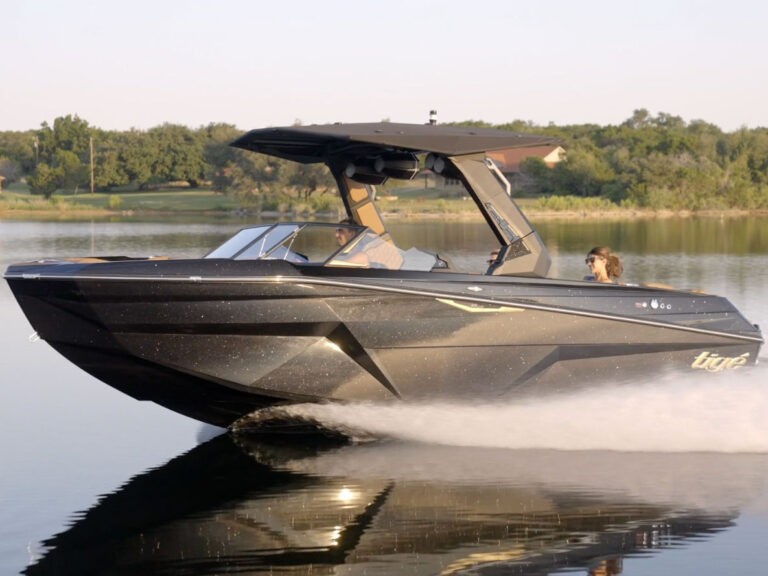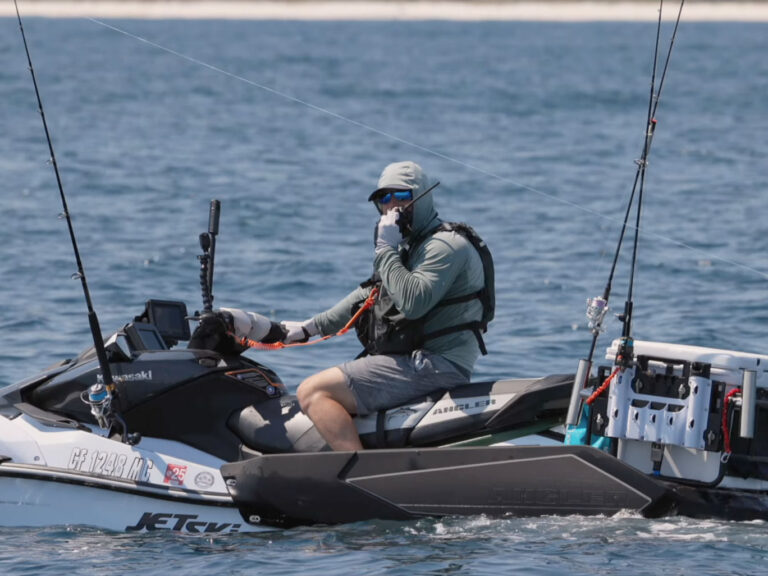
Beneteau Yachts’ The Greatest Loop, a Swift Trawler 34, just completed the Great Loop cruise, circumnavigating the eastern United States. What started as a brand-new boat in April, so new the styrene knocked us out when we opened a hatch, now has 600 hours on her Cummins MerCruiser diesel and 6,000 miles beneath her keel. That’s equivalent to about eight years of use for the average boater.

Use these tips to ensure that your new boat is thoroughly inspected.
We tested the Swift Trawler 34. But this project provided an opportunity to see how a brand-new boat stands up over time. We had the boat surveyed at Annapolis Yacht Sales by Robert A. Noyce and Associates, Marine Surveyors and Appraisers. Noyce is a four-decade pro. He’s worked for Lloyd’s of London, the European Union’s Recreational Craft Directive (RDC) and the American Boat and Yacht Council (ABYC). We’ll resurvey the boat to compare it with that baseline survey in an upcoming issue.
What the heck can a new-boat survey prove? Should you get one? How does the Beneteau fare? Read on and find out.

The Survey
Hire a surveyor and he’ll check everything from construction to rigging to safety and more. He’ll offer recommended changes, suggested changes, and give you a good indication if you are getting what you plan on paying for. This is all provided in a report that’s about as long as an issue of this magazine. For space considerations, we condensed Noyce’s report, starting with the boat’s mechanical systems.
10 Ways To Get Better Warrantee Service
Noyce found The Greatest Loop‘s engine well ventilated — able to deliver enough cubic feet per minute of air based on the needs of the engine and genset to consume oxygen. The exhaust system had heavy, toggle-style clamps, strong enough to withstand the weight of water it would have to bear while discharging exhaust. Since The Greatest Loop was brand-new, Noyce did not run a compression test, send oil out for analysis or inspect the engine zincs. He noted that the engine mounts were secure and properly adjusted, the types of things many new boats go back for warranty service on shortly after delivery.
The diesel fuel tank was constructed of 5052 aluminum, Noyce noted, sported properly made fillet welds and was equipped with approved fuel lines, vent hoses and fittings. A fuel shut-off was located at the remote manifold per ABYC. The fuel fills were located in a well-designed “overflow proof” locker high on the cabin side.
The shaft and propeller appeared true, an observation borne out in smooth operation during sea trial. Surveyors use a dial gauge to check for trueness in running gear. That makes it important to arrange a survey that takes place on land and includes a sea trial like ours did. A Glomex ground plate provided an earth bond — but curiously, the through-hull fittings were not bonded, which may increase their susceptibility to corrosion.
The electrical installation met the strict standards of the ABYC and the European CE/ISO (International Organization for Standardization) and RCD requirements. Noyce commented that “the ABYC standards and the extensive tables the council supplies to builders are my bible for both engineering and safety.” The shore-power inlets were located in a compartment set high on the stern above damaging splashes from rough seas. Getting to them required moving a cushion on a settee, less convenient than the common transom hatch, but the location was designed for reliability and longevity.
The grounded main 12-volt electrical panel included a vapor-proof battery selector switch. Two EP 450 and one EG 1102 Exide AGM batteries sat in acid-proof trays, with terminals well secured and covered to prevent fire-causing arcs and sparks per ABYC. The batteries themselves were secured so that they would not move more than one inch when a force of 90 pounds, or twice the battery weight, is applied. The positive terminals were covered to prevent short circuits. Both are requirements of ABYC.
The 110-volt system, installed on a separate electrical panel, was equipped with circuit breakers. Polarity was correct, and the ground fault circuit interruption system worked properly, which means safety for crew aboard.

Construction
Noyce “sounded” the bottom of the hull, tapping with a phenolic hammer and using his experienced ear to ferret out any voids in the laminate. None were found. He ran a moisture meter over the hull, another device requiring experience to use properly. Moisture meter levels were very low, taken before departure for comparison on the boat’s return from the Great Loop.
Although a hull liner covered most areas of the interior, he inspected the bulkheads, where accessible, and found no signs of working, rot, deterioration or delamination. Noyce commented that, with modern materials and bonding adhesives, a liner adds great strength to the hull. But there is a trade-off in the event of a collision, because the liner system causes more work to diagnose and repair since access is impeded. The taping of the bulkhead-to-hull bond was secure. All fillet bonds were properly wetted out and showed no signs of peeling, parting or cracking.
The stringer grid featured wide flanges, allowing the adhesive plenty of surface area to forge its chemical bond. The grid was continuous, running the length of the hull, and Noyce commented that this system distributes the strain from running through seas better than noncontinuous stringers do. Access to engine systems for normal maintenance was good, even to the outboard sides.

Other Systems
The galley’s stove and oven were fueled by an LPG tank mounted in an external compartment in the portside walkway per ABYC specs. The Greatest Loop‘s holding tank’s plumbing, raw-water supply and Y-valve all met current installation standards.
Noyce noted that the bilge pump was wired and fused outside the main 12-volt system so it can function when the vessel is unattended and the main battery selector is switched to the off position.

The Sea Trial
The sea trial added more valuable insights. On the flybridge, Noyce examined the boat’s mast, a powder-coated aluminum extrusion with a cast gooseneck mounted on a stainless-steel pin and Delrin washers for easy movement. Its heel was seated in a stainless tabernacle for easy lay-down when transiting bridges. An experienced cruiser, Noyce suggested mounting a stout pad eye at the center of the flybridge’s venturi with a double block with jam cleat for single-handed lowering of the mast. He also noted installation of stout pad eyes for securing a dinghy like a 10-foot, rigid-floor inflatable with a 10 to 15 hp outboard.
Out in the Chesapeake, with The Greatest Loop running 17 knots in two- to three-foot seas, I lay in the upper and lower berths of the boat’s small cabin to listen for creaks. Noyce commented that they were well within normal range for a new boat with a hull liner. We opened the forepeak hatch and looked to see if the hull’s forefoot flexed from the force of the bow slicing through the short, choppy seas at speed. It didn’t move at all.
Finally, in the salon, Noyce pointed to the sliding windows on both sides. Beneteau has equipped each with 1½-inch-high Lexan sills to prevent spray from coming inside and damaging the joinery. These are the kinds of details that pay dividends in keeping a boat in good condition throughout ownership.

The Good, the Bad
The Beneteau Swift Trawler 34 is a quality boat. And since we tested it, inspected it ourselves and have a surveyor’s report in hand, we’re confident in stating that fact. It’s designed with great attention to detail, it’s built well, its systems are solid and well installed, and it performs efficiently at both trawler and fast cruising speeds. It’s an eminently capable Great Loop cruiser.
But the survey still raised questions, in addition to those already mentioned. Though this boat is a coastal cruiser, it will have to weather rough water like that in the Chesapeake, the Great Lakes and the Gulf of Mexico. We were surprised that the only handhold in the salon was a (sturdy) vertical stainless pole over the galley. It should be easy to add a grab rail around the back of the pilot seat. Also the “pump village” under the vanity in the head is less than easily serviceable. Fortunately, Beneteau has labeled all of the pumps and hoses, as well as included flow diagrams in the extensive owner’s manual.
“The book is enough to get you started,” Noyce explained, “though reaching around inside there may require some contortions. No 34-footer has a truly easy pump village.”
Finally, although the fit and finish of the cabinetwork in the salon and cabin were nicely done, we observed slight gaps in some of the computer numerical control (CNC) cut pieces. We’ll revisit those locations when the boat returns from her voyage.
The Value of a New-Boat Survey
The value of a new-boat survey is in having a practiced eye double-check a builder’s quality control. Consider it a “trust, but verify” operation. Noyce charged us $340 for this survey, cheap insurance for a buyer who wants to ensure his new boat leaves the showroom “right.”
These results prove the value of a new-boat survey; since if we were prospective buyers, we could either negotiate to have the dealer or manufacturer beef up these features or make our offer based on having to take care of them ourselves. Check back on Part II to see how all of the Swift Trawler 34‘s features hold up.
How to Find a Surveyor
Robert Noyce sums up his function as “observe and report.” He suggests getting a third-party recommendation, and checking credentials, and also asking “What have been your boating experiences in design, construction, repair and time on the water? How did you become a surveyor? Can you give me a sample survey?”
We’ll add that, since members of the Society of Accredited Marine Surveyors (marinesurvey.org) and the National Association of Marine Surveyors (namsglobal.org) have a commitment to integrity and continuing training and education, those organizations are top-notch sources for surveyors.
Scroll through the gallery for even more new-boat survey tips.



